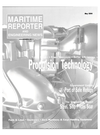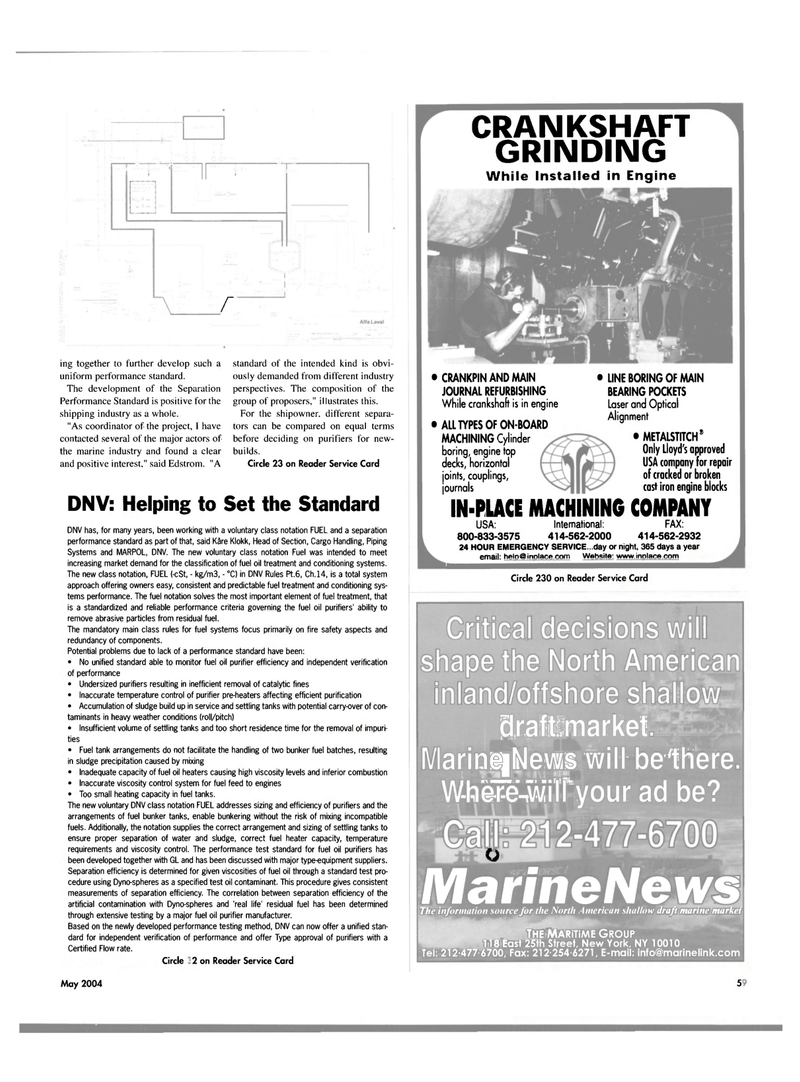
Page 4th Cover: of Maritime Reporter Magazine (May 2004)
The Propulsion Technology Yearbook
Read this page in Pdf, Flash or Html5 edition of May 2004 Maritime Reporter Magazine
r ing together to further develop such a uniform performance standard.
The development of the Separation
Performance Standard is positive for the shipping industry as a whole. "As coordinator of the project, I have contacted several of the major actors of the marine industry and found a clear and positive interest," said Edstrom. "A standard of the intended kind is obvi- ously demanded from different industry perspectives. The composition of the group of proposers," illustrates this.
For the shipowner, different separa- tors can be compared on equal terms before deciding on purifiers for new- builds.
Circle 23 on Reader Service Card
DNV: Helping to Set the Standard
DNV has, for many years, been working with a voluntary class notation FUEL and a separation performance standard as part of that, said KSre Klokk, Head of Section, Cargo Handling, Piping
Systems and MARPOL, DNV. The new voluntary class notation Fuel was intended to meet increasing market demand for the classification of fuel oil treatment and conditioning systems.
The new class notation, FUEL (-cSt, - kg/m3, - °C) in DNV Rules Pt.6, Ch.14, is a total system approach offering owners easy, consistent and predictable fuel treatment and conditioning sys- tems performance. The fuel notation solves the most important element of fuel treatment, that is a standardized and reliable performance criteria governing the fuel oil purifiers' ability to remove abrasive particles from residual fuel.
The mandatory main class rules for fuel systems focus primarily on fire safety aspects and redundancy of components.
Potential problems due to lack of a performance standard have been: • No unified standard able to monitor fuel oil purifier efficiency and independent verification of performance • Undersized purifiers resulting in inefficient removal of catalytic fines • Inaccurate temperature control of purifier pre-heaters affecting efficient purification • Accumulation of sludge build up in service and settling tanks with potential carry-over of con- taminants in heavy weather conditions (roll/pitch) • Insufficient volume of settling tanks and too short residence time for the removal of impuri- ties • Fuel tank arrangements do not facilitate the handling of two bunker fuel batches, resulting in sludge precipitation caused by mixing • Inadequate capacity of fuel oil heaters causing high viscosity levels and inferior combustion • Inaccurate viscosity control system for fuel feed to engines • Too small heating capacity in fuel tanks.
The new voluntary DNV class notation FUEL addresses sizing and efficiency of purifiers and the arrangements of fuel bunker tanks, enable bunkering without the risk of mixing incompatible fuels. Additionally, the notation supplies the correct arrangement and sizing of settling tanks to ensure proper separation of water and sludge, correct fuel heater capacity, temperature requirements and viscosity control. The performance test standard for fuel oil purifiers has been developed together with GL and has been discussed with major type-equipment suppliers.
Separation efficiency is determined for given viscosities of fuel oil through a standard test pro- cedure using Dyno-spheres as a specified test oil contaminant. This procedure gives consistent measurements of separation efficiency. The correlation between separation efficiency of the artificial contamination with Dyno-spheres and 'real life' residual fuel has been determined through extensive testing by a major fuel oil purifier manufacturer.
Based on the newly developed performance testing method, DNV can now offer a unified stan- dard for independent verification of performance and offer Type approval of purifiers with a
Certified Flow rate.
Circle 204 on Reader Service Card
CRANKSHAFT GRINDING
While Installed in Engine • CRANKPIN AND MAIN
JOURNAL REFURBISHING
While crankshaft is in engine • ALL TYPES OF ON-BOARD
MACHINING Cylinder boring, engine top decks, horizontal joints, couplings, journals • LINE BORING OF MAIN
BEARING POCKETS
Laser and Optical
Alignment • METALSTITCHs
Only Lloyd's approved
USA company for repair of cracked or broken cast iron engine blocks
IN-PLACE MACHINING COMPANY
USA: International: FAX: 800-833-3575 414-562-2000 414-562-2932 24 HOUR EMERGENCY SERVICE...day or night, 365 days a year email: [email protected] Website: www.inplaw.csm
Circle 230 on Reader Service Card draft market s-a- - larinefNews will be there • I II •filp II W-her-enWill your ad be? o MarineNews
The information source for the North American shallow draft marine market
THE MARITIME GROUP 118 East 25th Street, New York, NY 10010
Tel: 212-477-6700, Fax: 212-254-6271, E-mail: [email protected]
May 2004 57

 3rd Cover
3rd Cover

